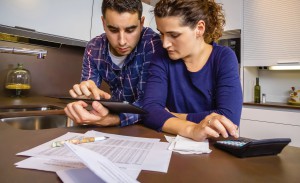Debt continues to plaque many families today, with the average U.S. household carrying more than $15,000 in credit card debt, according to CNN Money.
However, we want to encourage you that there is a way out. To put it simply, if you want different results, you’re going to have to live differently.
Taking that first step can be overwhelming. We liken it to learning to ride a bike, as the first time you hop on without training wheels is usually the most daunting.
Getting out of debt takes focus and perseverance, but we think the good news is that anyone can do it. Here are the five main steps to getting out of debt.
Stop adding to your debt.
It may sound simple, but the first thing you need to do is stop taking on more debt. This may mean adjusting your lifestyle so that you’re not spending more than you make, or perhaps you need to consider cutting up that store credit card.
Create a plan.
Identify all of your debts, and then write down how much is owed and to whom, and what the interest rate is.
We suggest targeting your smallest loan amount first. Paying off even a very small debt will give you momentum toward your goal to be debt-free. So even if you have higher interest rates on other debt, it helps give you traction to eliminate even one debt.
Of course if you have debt amounts that are similar with a large difference in interest rate, you should consider paying off the one with a high interest rate first to save a considerable amount of money in interest.
Add to your debt re-payments.
Decide if you have any way to free up extra money in your budget or search for ways to make extra income, in order to reach your goals even faster. To see results, you may need to make some changes to your lifestyle – which often includes sacrifice. But in the end, by giving up trivial things here and there – a latte or a fast food lunch run or a new shirt – you will be gaining the freedom of ultimately being able to tell your money where to go and to save for the future, instead of handing it all over to debt payments.
Roll your debt payments to the next debt.
Each time you pay off a loan or credit card, celebrate – and then move on to the next one on your list. Apply any payments for debt that has been eliminated to the next debt on your list.
If you pay off your credit cards, take that payment amount and then apply it to what you were paying on car loans, which means that you’ll be adding to your minimum payments – saving a lot on interest and knocking out the debt more quickly. Once the car loans are paid off, take that payment and apply it to your student loan payment or mortgage, and so on.
Keep everyone accountable and monitor progress.
Hold regular financial meetings with your spouse or your family to keep yourselves accountable. It’s so exciting to see your debt being eliminated as you progress toward personal financial freedom! Seeing the progress you are making will further your drive to get out and stay out of debt.
If you are in debt and looking for a way out, the most intimidating step can often be the first. Create a plan for reducing and eliminating your debt, as well as creating and maintaining a personal budget.